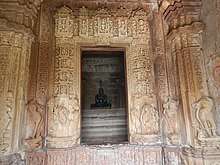Adinatha temple, Khajuraho
| Adinatha temple | |
|---|---|
| आदिनाथ मन्दिर | |
|
| |
 Location in Madhya Pradesh, India  Adinatha temple, Khajuraho (India) | |
| Basic information | |
| Location | Khajuraho |
| Geographic coordinates | 24°50′42″N 79°56′12″E / 24.845111°N 79.936607°ECoordinates: 24°50′42″N 79°56′12″E / 24.845111°N 79.936607°E |
| Affiliation | Jainism |
| Deity | Adinatha |
| District | Chhatarpur |
| State | Madhya Pradesh |
| Country | India |
| Date established | 11th century CE |
Adinatha temple (IAST: Ādinātha Mandir) is a Jain temple located at Khajuraho in Madhya Pradesh, India. It is dedicated to the Jain tirthankara Adinatha, although its exterior walls also feature Hindu deities. This temple is part of UNESCO World Heritage Site along with other temples in Khajuraho Group of Monuments.
History

The Adinatha temple is dated to the late 11th century CE.[1] It was probably constructed slightly later than the Vamana temple.[2]
In the garbhgraha, there is a black schist (or basalt) statue of Lord Adinath with a three line inscription. It gives the date (samvat 1215 (1158 AD). It gives the name of the donor as Kumarnandi and the sculptor as Ramaveva. It mention that Kumarnandi was the disciple of Bhanukirti, who was disciple of Rajanandi, who was disciple of Ramachandra of Mula Sangha. The inscription includes 3 shardulavikridita verses in literary Sanskrit.[3]
The temple has been classified as a Monument of National Importance by the Archaeological Survey of India.[4]
Architecture
The plan and design of the Adinatha temple is similar to that of the Vamana temple. There are only a few differences between the two temples. For example, the top row of the outer wall of the Adinatha temple depicts a flying vidyadhara, while that of the Vamana temple shows diamond-shaped decorations. The curvilinear tower of the Adinatha temple is of better proportions than that of the Vamana temple. This, combined with a somewhat more evolved sculptural style, suggests that the Adinatha temple was constructed after the Vamana temple.[1]
Only two major parts of the temple now survive: the vestibule and the sanctum.[2] The roof of the vestibule is particularly remarkable for its elegant design.[1]
Sculptures

The exterior walls of the temple have three bands of sculptures featuring surasundaris (graceful women), flying vidyadhara couples, vyalas (mythical lion-like being), and a dancer with musicians.[2] Despite the shrine's Jain affiliation, the external walls also feature carvings of the Hindu deities.[5] The niches feature sculptures of the Jain Yakshinis: Ambika, Chakreshvari, and Padmavati.[2]
One sculpture found at the temple shows a sitting Adinatha with a ushnisha on his head. It features a dharmachakra with a small bull figure.[6] The right side of the seat has the figure of a pot-bellied yaksha with a cup and a moneybag in his hands. The left side has the figure of the yakshini Chakreshvari sitting on a Garuda. She has four arms; each of the two upper arms hold a chakra.[7]
Another sculpture with similar iconography also features a yaksha, a yakshini, and a bull with a dharmachakra. The Adinatha is shown sitting in padmasana pose on a cushioned seat with lotuses and diamond motifs.[7]
References
- 1 2 3 ASI Bhopal Adinatha 2016.
- 1 2 3 4 Ali Javid & Tabassum Javeed 2008, p. 210.
- ↑ [B.L Nagarch, Jaina Inscriptions of Khajuraho, In Hīrālāla Jaina Smriti Granth, Dharmacandra Jaina & R. K. Sharma (eds.), Sharada Pub. House. pp. 69-74 (2002)]
- ↑ ASI MP List 2016.
- ↑ Ali Javid & Tabassum Javeed 2008, p. 209.
- ↑ Umakant Premanand Shah 1987, p. 121.
- 1 2 Umakant Premanand Shah 1987, p. 122.
Bibliography
| Wikimedia Commons has media related to Adinath Jain Temple Khajuraho. |
- Ali Javid; Tabassum Javeed (2008). World Heritage Monuments and Related Edifices in India. Algora. ISBN 978-0-87586-482-2.
- "Adinatha Temple". Archaeological Survey of India, Bhopal Circle. Retrieved 2016-11-16.
- "Alphabetical List of Monuments - Madhya Pradesh". Archaeological Survey of India, Bhopal Circle. Archived from the original on 2 November 2016. Retrieved 16 November 2016.
- Umakant Premanand Shah (1987). Jaina Iconography. Abhinav. ISBN 9788170172086.